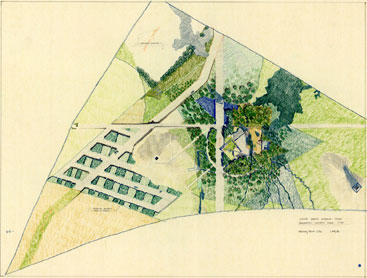Building, Destroying or Ignoring: Examining Creative Relationships to a Past—Palimpsest as Metaphor
Introduction: Young Riddle (director of the Nimbus Institute, created to investigate the deeper aspects of music performed by the Nimbus Ensemble)
- picture of palimpsest—first erased, but traces remain, second written at perpendicular
- Archimedes text written over by Christian text
Wim De Wit (curator of architectural collections at the Getty Research Institute)
“The Surface Scratched, or Traces Exposed: The Built Environment as a Palimpsest”
- palimpsest in architecture is NOT graffiti or signs painted/pasted over
- Union Station (1929-1939): idea for centralized rail location, but railroads did not want to pay and no one could decide where to locate it; battle for 15 years; built where original Chinatown was—in 1934 bulldozed over, seemingly completely erased; built in the CA/mission style with some French style inside, with no reference to what had been there before; (Julius Schumann—architectural photographer); in 1985 and 86 when excavation started for Metro rail, they found thousands of pieces of china and other artifacts, so the erasure was not complete

- Peter Eisenman (New York): art museum project for Cal State Long Beach (1985-86); “artificial excavations”; figure and ground; endow the site with a history that wasn’t there to begin with—layers of history; Eisenman found out certain things about history of CA and the University and put them into the architectural plans, such as shape of Rancho Los Alamitos (1849), shape of Long Beach campus (founded 1949), future shapes (2049), (1989)
- Frank Gehry house in Santa Monica (1978 began, built 1987): structure and surfaces; said “building under construction looks better” and that sentiment defined some of his style in the ’80s; he built the expansion of the house over the old house without changing the facade of the old; plywood, redwood, glass on top, see through to old
- Piazza Navona, Rome: layers of history; on top of ruins of a race track/circus; and the fountain itself is palimpsest—Egyptian obelisk on top of sculpture by Vernini

Marjorie Luesebrink, aka M.D. Coverley (director and past president of the Electronic Literature Organization, hypertext fiction author)
“The Palimpsest in Electronic Literature: Refreshing Modalities”
- Katherine Hayles
- much of critique and aesthetic of literary thought based on written page
- digitized art in museums?
- computer screen is palimpsest in continuation, constantly refreshing, changing images
- hypertext (note: I like to think of Choose Your Own Adventure books and forward-thinking, pre-html hypertexts)
- (note: programmers as writers? special breed)
- (note: need def. what kind of site is “electronic literature” and what is just information. some information sites very creative)
Dan Hosken (associate professor of music at Cal State Northridge, composer of acoustic and electronic music)
“Erasing Xenakis: Creating a Palimpsest of Palimpsest”
- Iannis Xanakis Palimpsest (1979)
- explains how he worked with this piece based on early overwriting procedures: unbind, erase, cut, turn, overwrite, rebind
- palimpsests reuse something of value (parchment/vellum). what is of value to musician is not the notes/recording, but the audience attention.
- to overwrite a document, must have hostile or at least indifferent attitude toward the text. this was difficult for Hoskin.
- erase progressively the music in various ways as he moved through the piece, and like the Archimedes, the original text breaks through sometimes
- Hoskin’s work, overwriting the orig., was “digitally born”
etc.:
“The traditional role of architecture has been not only to realize a sheltering function, but to represent and symbolize it as well. It is proposed in this project that while a museum must shelter art, it does not necessarily follow that it must symbolize its activity. Instead, it could represent the relationship of art to society, raise questions about the museum as a social institution, or it could propose a new representation of that institution.”—Peter Eisenman, read more
[event details]________________
Sat., March 24, 2pm, FREE
Hammer Museum
10899 Wilshire Blvd
Los Angeles, CA 90024
The Nimbus Institute & Hammer Museum present:
“Building, Destroying or Ignoring: Examining Creative Relationships to a Past—Palimpsest as Metaphor”
“In tandem with the Nimbus Ensemble’s March 29 concert in Zipper Hall, the Nimbus Institute presents three renowned scholars exploring intriguing aspects of the past-present relationship. These stimulating lectures will examine how substrata from a past interacting with present surface features informs our understanding and aesthetic responses.”
